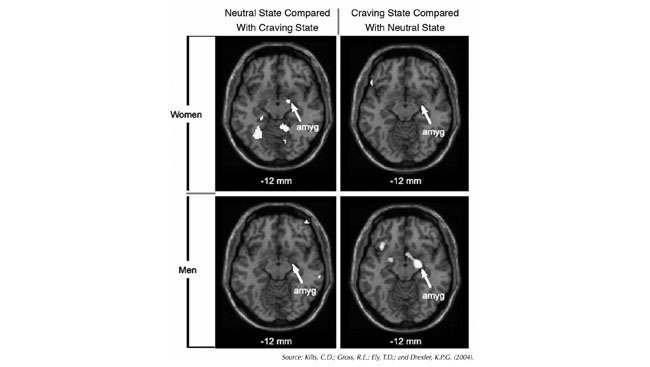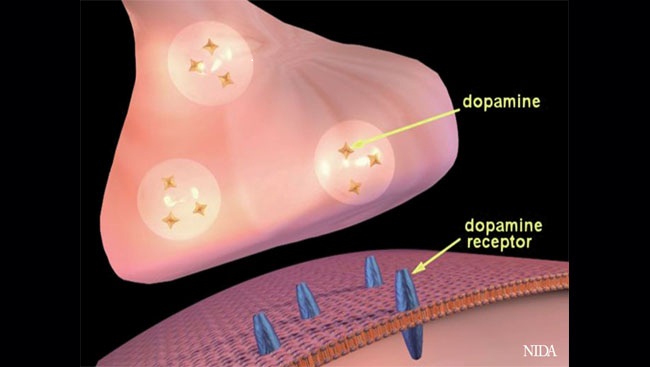Reward and Punishment
- Published31 Dec 2010
- Reviewed31 Dec 2010
- Author Sarah Bates, MS, MA
- Source BrainFacts/SfN
Drug abuse and addiction disturb the brain’s natural pleasure-producing reward system, altering self-control and decision-making abilities on a cellular level. Of all Americans age 12 or older, more than 9 percent have struggled with drug dependence and 20 percent with nicotine addiction. For these people, a once-voluntary source of pleasure segues into a destructive habit.

Addictive Circuit Breakers
When a person takes an addictive substance — whether it be in pill, syringe, or cigarette form — chemicals travel through the blood stream into the brain, where they act on key regions. Each of these drugs provides an artificial chemical boost to the body’s reward system.
The brain circuit underlying reward makes biologically necessary actions, such as eating and reproducing, feel good. The circuit consists of nerve cells that cluster in a region near the base of the brain called the ventral tegmental area. These cells extend fibers toward the front of the brain, specifically to a collection of neurons called the nucleus accumbens.
Substances of abuse seize this reward system, throwing it out of balance. The drugs create an artificially blissful high, one that is often more intense than naturally euphoric actions. But the brain adapts — the abused system becomes desensitized.

Lab studies have shown, like humans, rats will repeatedly selfadminister drugs, prioritizing that immediate high over even eating. Even if the animals are removed from the drugs for months, they will quickly return to drug-taking behaviors if stress or certain environmental cues are introduced.
A Dangerous Cycle
Different drugs work in the same basic way — they all increase the action of the chemical dopamine. Like other chemical messengers that transmit information in the brain, dopamine attaches to special sites on cells called receptors that send and receive signals. When drugs spur the release of abnormally large amounts of dopamine, the body adjusts by decreasing the number of its receptors. Drug users must then consume more drugs to achieve the same high, while drug tolerance similarly increases. Thus, the addiction cycle is set.
Recent studies with rhesus monkeys show cocaine use reduces the production of dopamine receptors of a particular subtype, called the D2 receptor. The D2 receptor is in the outer membranes of brain cells found to shape motivation, emotion, thought, and movement. This protein allows dopamine to influence the function of these cells. Studies show fewer D2 receptors in people who abuse nicotine, heroin, and alcohol, and even in the severely obese.
Compounding the effect of dopamine receptor loss, research also indicates chronic drug abusers have less dopamine in their brains, perhaps to compensate for repeated surges in the reward system. This explains why addicts often feel depressed and anxious when sober.
Importance of Genetics and the Environment
Researchers are now learning more about the role that genetics plays in addiction. Research indicates that many genes influence how likely a person is to become addicted. Although there is no “addiction gene,” studies show a single gene variation may have considerable effects.
For example, recent research funded by the National Institute on Drug Abuse shows an animal’s response to nicotine may depend on the particular composition of its nicotine receptors. One type of gene variation may alter the receptor composition in a way that increases the risk for addiction, while another variation may decrease risk. Scientists are still unraveling how the complex cocktail of genes mixes to better understand addiction and its affect on health.
Environmental factors also play a key role in addiction. Scientists estimate 40 to 60 percent of a person’s susceptibility to addiction may be determined by the effects of environment on genes. The risk is greater for adolescents and people with mental disorders than for the general population.
Addicts can recover. The brain has a remarkable ability to mend from drug use. Imaging studies show that dopamine levels eventually increase to near-normal after months of abstinence. In addition to traditional behavioral therapy, new pharmacological treatments may prove a valuable aid to addicts. Better knowledge of genetic and environmental factors will help medical professionals develop more effective methods of getting addicts off of drugs — permanently.
CONTENT PROVIDED BY
BrainFacts/SfN
Also In Archives
Trending
Popular articles on BrainFacts.org


















